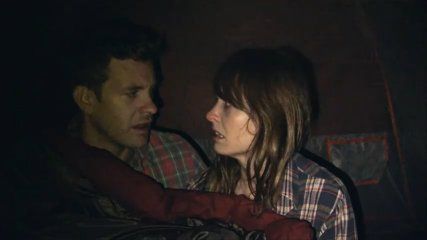I think we have to rethink this whole "going into the woods" thing.

What a difference a decade makes. The last time Bobcat Goldthwait made a mockery of the documentary form, it was as a gun for hire on 2003's Windy City Heat. Now, with three independent features under his belt, he's taken a dip into the found-footage pool with Willow Creek, which IU Cinema got the jump on ahead of its New York premiere. Not only that, we got Goldthwait in the flesh to introduce the film and answer questions afterwards. (His irreverent take on the underpinnings of most found-footage flicks: "I'm sorry your family got raped to death, but if we re-cut it I think we've got quite a picture here.")
Even if Goldthwait hadn't told us right at the top, it would have become clear soon enough that he made his film on a shoestring. And as he copped to afterwards, it is indeed heavily indebted to The Blair Witch Project. Unlike a lot of the brazen cash grabs that followed in that film's wake, though, Willow Creek doesn't skimp on one of the essentials that all films should have: compelling characters that we can relate to, grow to care about, and legitimately be frightened for when the Bigfoot scat hits the tent.
Yes, Bobcat made a Bigfoot movie.
This particular Bigfoot movie is about a young couple (aspiring actress Alexie Gilmore, Bigfoot believer Bryce Johnson) who venture into Trinity National Forest in Northern California with a video camera and camping gear in search of the site where Roger Patterson and Bob Gimlin shot their famous film of a female Bigfoot in 1967. First, though, they pay a visit to the title town, which Johnson calls "Mecca to the Bigfoot community." There they eat Bigfoot burgers, check into the Bigfoot Motel, look around the Bigfoot Museum, and browse Bigfoot Books, where they get directions to the site. (This section of the film, which echoes the opening of Blair Witch, features interviews with actual residents of the town, plus a ranger played by John Carpenter regular Peter Jason, who tells a harrowing story about a hunting trip gone bad.) All the while, the two of them banter and record the footage that Johnson plans to incorporate into his own documentary, even going so far as to do multiple takes of some of his scripted patter. The laughter dries up and the unease mounts when they head out into the wild, though.
As they drive deeper and deeper into the forest, Gilmore quips, "I have no cell reception. Beginning of every horror film." Then they encounter another horror cliché: the angry local who uses the threat of physical harm to warn them off. Johnson will not be deterred, though, and they find an alternate entrance and, once they reach the end of the road, set off on foot in the direction of Bluff Creek, where it all went down 45 years earlier. To Johnson's chagrin, Gilmore tires out before they get there, forcing them to set up camp, which gets trashed while they explore the area (and he bravely goes skinny-dipping). Goldthwait saves the big scares for nightfall, though, and a bravura, 19-minute-long unbroken take of the two of them in their tent after they're awoken by strange knocking and vocalizations. What's especially amazing about it is how tense Goldthwait is able to make the scene without showing anything. And the same goes for the denouement, during which he avoids showing us the creature that attacks our heroes. Some may call it a cheat, but I call it smart filmmaking, pure and simple.